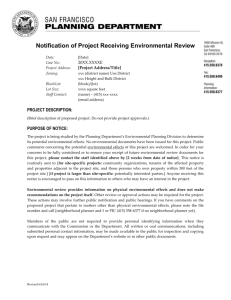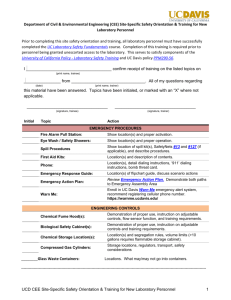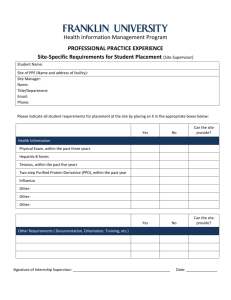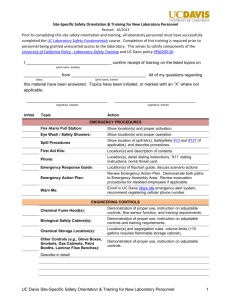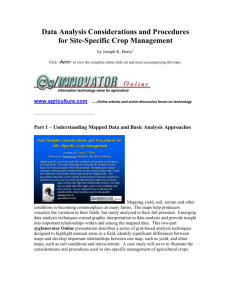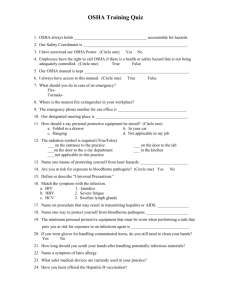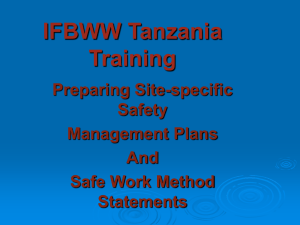Evaluation of the Updated Site-Specific Risk Defense Facility in Manhattan, Kansas
advertisement
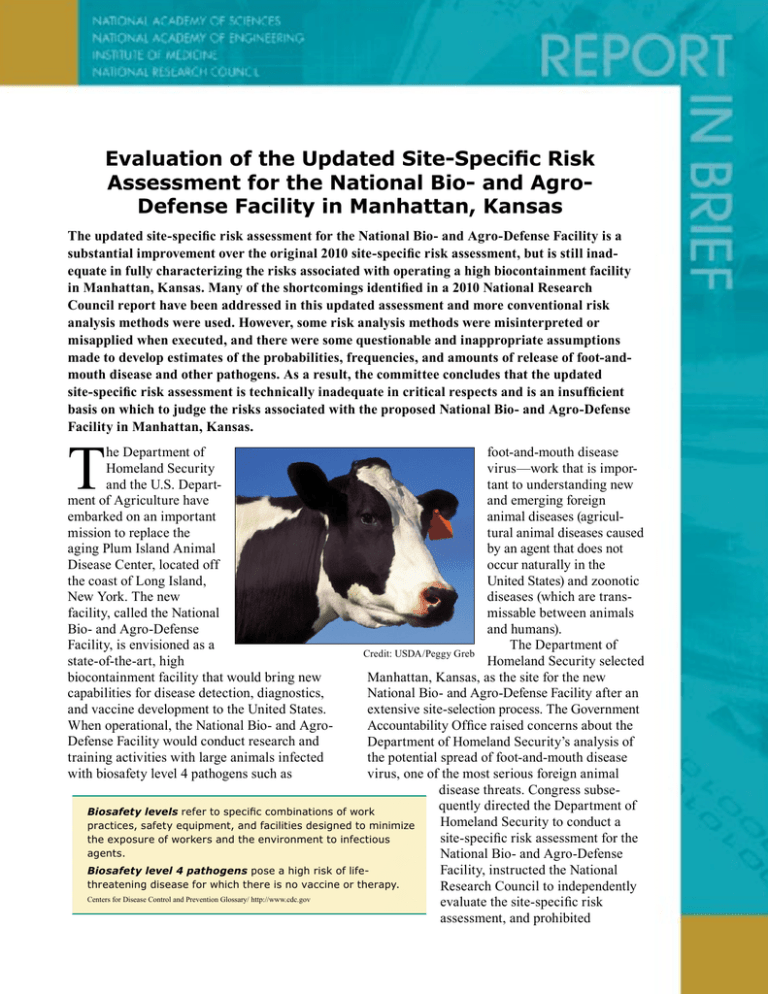
Evaluation of the Updated Site-Specific Risk Assessment for the National Bio- and AgroDefense Facility in Manhattan, Kansas The updated site-specific risk assessment for the National Bio- and Agro-Defense Facility is a substantial improvement over the original 2010 site-specific risk assessment, but is still inadequate in fully characterizing the risks associated with operating a high biocontainment facility in Manhattan, Kansas. Many of the shortcomings identified in a 2010 National Research Council report have been addressed in this updated assessment and more conventional risk analysis methods were used. However, some risk analysis methods were misinterpreted or misapplied when executed, and there were some questionable and inappropriate assumptions made to develop estimates of the probabilities, frequencies, and amounts of release of foot-andmouth disease and other pathogens. As a result, the committee concludes that the updated site-specific risk assessment is technically inadequate in critical respects and is an insufficient basis on which to judge the risks associated with the proposed National Bio- and Agro-Defense Facility in Manhattan, Kansas. T he Department of Homeland Security and the U.S. Department of Agriculture have embarked on an important mission to replace the aging Plum Island Animal Disease Center, located off the coast of Long Island, New York. The new facility, called the National Bio- and Agro-Defense Facility, is envisioned as a state-of-the-art, high biocontainment facility that would bring new capabilities for disease detection, diagnostics, and vaccine development to the United States. When operational, the National Bio- and AgroDefense Facility would conduct research and training activities with large animals infected with biosafety level 4 pathogens such as foot-and-mouth disease virus—work that is important to understanding new and emerging foreign animal diseases (agricultural animal diseases caused by an agent that does not occur naturally in the United States) and zoonotic diseases (which are transmissable between animals and humans). The Department of Credit: USDA/Peggy Greb Homeland Security selected Manhattan, Kansas, as the site for the new National Bio- and Agro-Defense Facility after an extensive site-selection process. The Government Accountability Office raised concerns about the Department of Homeland Security’s analysis of the potential spread of foot-and-mouth disease virus, one of the most serious foreign animal disease threats. Congress subsequently directed the Department of Biosafety levels refer to specific combinations of work Homeland Security to conduct a practices, safety equipment, and facilities designed to minimize site-specific risk assessment for the the exposure of workers and the environment to infectious agents. National Bio- and Agro-Defense Biosafety level 4 pathogens pose a high risk of lifeFacility, instructed the National threatening disease for which there is no vaccine or therapy. Research Council to independently Centers for Disease Control and Prevention Glossary/ http://www.cdc.gov evaluate the site-specific risk assessment, and prohibited Box 1. What is Foot-and-Mouth Disease? Foot-and-mouth disease is a highly contagious and deadly viral disease of cloven-hoofed animals such as cows and sheep and constitutes a major threat to the livestock industry. The United States has been free of foot-andmouth-disease since 1929, and research on live foot-and-mouth disease virus has not been permitted on the U.S. mainland since 1937. obligation of National Bio- and Agro-Defense Facility construction funds until the National Research Council review was complete. A previous National Research Council report, released in 2010, found that the site-specific risk assessment was inadequate due to flawed methods and assumptions which potentially underestimated the risk of an accidental foot-and-mouth disease virus release from the National Bio- and Agro-Defense Facility in Manhattan, Kansas. In response, Congress again withheld construction funds and mandated that the Department of Homeland Security update its sitespecific risk assessment to address shortcomings, and asked that the National Research Council evaluate the updated site-specific risk assessment. Meeting the Congressional Mandate The updated site-specific risk assessment is a substantial improvement over the original 2010 site-specific risk assessment, addressing many shortcomings identified in the previous National Research Council report. Despite these improvements, the report’s authoring committee finds that the shortcomings in the updated site-specific risk assessment likely underestimate the risks of pathogen release and infection and inadequately characterize the uncertainties of these risks. The 2010 site-specific risk assessment showed that for the two greatest release scenarios, there is nearly a 70 percent probability that a release of foot-and-mouth disease virus could result in an infection outside the laboratory over the 50-year lifespan of the National Bio- and Agro-Defense Facility in Manhattan, Kansas. In contrast, the updated site-specific risk assessment concludes that the cumulative probability for 142 risk events leading to an accidental release of foot-andmouth disease virus over 50 years is about 0.11 percent (or a 1 in 46,000 chance per year). Improvements in the design of the facility may account for some risk reduction, but the committee believes that questionable and inappropriate assumptions used in the updated site-specific risk assessment lead to artificially lower estimates of the probabilities and amounts of pathogen released. Because the updated site-specific risk assessment contains inconsistent information, it has been difficult to interpret data or to reconstruct risk scenarios in order to determine the degree to which risks were underestimated. These deficiencies and others lead the report’s authoring committee to conclude that the updated site-specific risk assessment continues to be inadequate in characterizing the risks associated with operating the National Bio- and Agro-Defense Facility in Manhattan, Kansas. The Use and Application of Risk Models The updated site-specific risk assessment uses a quantitative modeling framework that includes the identification of risk scenarios, total calculation of risk of all events, and uncertainty analysis— an important advance over the 2010 risk assessment. The committee identified concerns about how the framework was implemented and found that methods were inconsistently applied across the various sections of the updated site-specific risk assessment and that probabilistic dependencies in calculating risk scenarios were ignored, resulting in potentially serious underestimations of total risk and incorrect ranking of risk contributors. A critical part of risk analysis is characterizing the uncertainty of the results. The updated site-specific risk assessment’s characterization and assessment of uncertainties was incomplete and inconsistent, leading to a false sense of precision and limiting its utility for decision-making. The updated site-specific risk assessment uses very low rates caused by human error that are not supported by published literature or empirical experience. The 2010 site-specific risk assessment concluded that human error would be the most likely cause of release, and the previous National Research Council report agreed with that conclusion. Little justification is provided for the assumption that the rate of error for National Bio- and Agro-Defense Facility workers will be several times less than that of similarly skilled Box 2 The Proposed Site of the National Bio- and Agro-Defense Facility The proposed site of the National Bio- and Agro-Defense Facility is on the Kansas State University campus, bordering the Biosecurity Research Institute and adjacent to the College of Veterinary Medicine. About 10 percent of the nation’s cattle reside within a 200-mile radius of Manhattan, Kansas —and approximately 45 percent of the nation’s cattle reside in the seven states modeled as the expected impact area in the updated site-specific risk assessment. This makes the region a major hub for transportation of cattle and other livestock for the entire United States. workers in similar facilities, and it does not account for the possibility that routine tasks can be associated with high failure rates even when tasks are carried out by highly trained workers. Model Parameters and Assumptions The committee questioned the input data and parameters used in the updated site-specific risk assessment, noting that underestimates of parameter values could shift final results by many times more. In several places, the updated site-specific risk assessment did not describe the approaches used to ensure a thorough review of parametric inputs, making it impossible to determine whether the scientific literature and other information used to support risk assessment assumptions have been thoroughly evaluated. Many parameter estimates depended on outdated references or on only a single reference. At times, the lowest resulting risk input factors were selected, despite the availability of other data yielding higher risk. Epidemic Modeling The updated site-specific risk assessment estimated the consequences of a potential release of foot-andmouth disease virus from the proposed National Bio- and Agro-Defense Facility using the North American Animal Disease Spread Model in conjunction with data, statistical methods, and references from the scientific literature. Outputs from the model were used to evaluate the impact of the spread of foot-and-mouth disease virus through Kansas and into six adjoining states in different release events. The updated site-specific risk assessment addressed some previous criticisms of its epidemic modeling, but there are still significant limitations in model capabilities and available data. These, along with some overly optimistic assumptions about response resources and capacities anticipated to be available when the facility opens, lead to underestimates of the magnitude, spread, and the duration of a foot-and-mouth disease outbreak from the proposed facility. Economic Analysis The updated site-specific risk assessment includes a comprehensive economic analysis that uses models to determine the impact of factors such as depopulating livestock during an outbreak and reduced exports of livestock products on market prices, quantities, economic welfare, and expenditure. Although the methods used for the economic analysis are appropriate, sufficient information to replicate the results or to assess whether the analysis was properly executed was not provided. Under­ estimates of the magnitude, spread, and duration of a foot-and-mouth disease outbreak from the epidemic modeling were carried over into the economic model, likely leading to an underestimate of the economic consequence of a foot-and-mouth disease virus escape from the facility. Treatment of Natural Hazards The updated site-specific risk assessment concludes that a release caused by a natural hazard, such as a tornado or earthquake, is 20 times more likely than a release caused by an error or failure during normal facility operations. The committee questions this conclusion and finds that the updated site-specific risk assessment overestimates the likelihood of a release caused by a natural hazard. Although Kansas is prone to high winds due to tornadoes, it is a region of relatively low seismicity, and furthermore, the low structural fragility (strong resistance) of the proposed facility design is not taken into account. Surveillance, Response, Mitigation Surveillance, detection, and emergency response capabilities (such as the availability of vaccines) are critical for mitigating the effects of an outbreak, but are not yet in place. The updated site-specific risk assessment modeled disease release mitigation, response, and detection based on Department of Homeland Security and United States Department of Agriculture expectations for significantly improved plans, programs, and strategies to be implemented by the time the facility opens in 2020. However, there was no indication that the necessary science-based capabilities for foot-and-mouth disease surveillance and response would be fully developed and implemented by the time the proposed 2020 opening of the facility. If they are not, the risks and consequent impacts of a disease outbreak will be greater than estimated. Personnel Training The updated site-specific risk assessment fails to include Department of Homeland Security plans for personnel training in security, laboratory procedures, and emergency response as required by the Public Health Security and Bioterrorism Preparedness and Response Act of 2002. Those plans are critical for ensuring safe operations at the National Bio- and Agro-Defense Facility and for mitigating an accidental foot-and-mouth disease virus release from the laboratory. Exclusion of such information leads the committee to believe that preparations for the requirement have not been fully addressed by the Department of Homeland Security. This raises the possibility that risks that needed to have been considered were never actually considered or modeled as part of the current risk assessment. Evaluation of Biosafety Level 4 Assessment The updated site-specific risk assessment does not consider overall risk for biosafety level 4 work and presents a limited semi-quantitative assessment of impact. It focused exclusively on the unique risks associated with handling large animals in biosafety level 4 containment and provides only a minimal risk estimate by considering only Nipah and Hendra viruses. The updated site-specific risk assessment does not adequately consider the totality of risks in the biosafety level 4 suite, and likely underestimates the overall risk. Updated Design Plans The latest designs for the National Bio- and AgroDefense Facility are 65 percent complete. The report’s authoring committee reviewed the design documents to understand the assumptions about the release probabilities for the risk assessment and to verify that design concerns raised in the previous National Research Council report were addressed. The committee noted that inadequacies in the updated assessment do not imply inadequacies in the facility design. It was beyond the committee’s task to formally review or pass judgment on the actual engineering or safety of the facility. Limited Applicability of the Updated Site-Specific Risk Assessment For any risk assessment, results apply only when they are based on assumptions that are consistent with practice. The updated site-specific risk assessment makes key assumptions about the physical design of the facility, its maintenance and operation, and the implementation of mitigation strategies, and therefore any significant deviation from the assumed characteristics will modify risk factors and reduce the validity of the risk assessment. It is critical to recognize sufficient funding for the National Bio- and Agro-Defense Facility and for risk mitigation activities would be required to carry out the planned assumptions noted in the updated site-specific risk assessment. Without a long-term funding commitment sufficient to maintain the level and quality of operations and sustain planned mitigation strategies, the findings provided in the updated site-specific risk assessment would not be assured. Inclusion of a careful sensitivity analysis based on alternative assumptions might have made the updated site-specific risk assessment applicable. In the absence of a thorough sensitivity analysis, the applicability of the updated site-specific risk assessment under alternative operational conditions could not be ascertained. Read or purchase this report and locate information on related reports at http://dels.nas.edu/banr Committee on the Evaluation of the Updated Site-Specific Risk Assessment for the National Bio- and Agro-Defense Facility in Manhattan, Kansas: Gregory B. Baecher (Chair), University of Maryland; Thomas W. Armstrong, TWA8HR Occupational Hygiene Consulting, LLC; Richard E. Breitmeyer , University of California, Davis; Corrie Brown, University of Georgia; Mark T. Hernandez, University of Colorado, Boulder; Ahsan Kareem, University of Notre Dame; Brendan McCluskey, University of Medicine and Dentistry of New Jersey; Ali Mosleh, University of Maryland; Stephen M. Ostroff, Pennsylvania Department of Health; Philip Paarlberg, Purdue University; Timothy C. Reluga, Pennsylvania State University; Joseph V. Rodricks, ENVIRON; James A. Roth, Iowa State University; Lee H. Thompson, University of Texas Medical Branch, Galveston; Mark C. Thurmond, University of California, Davis; Akula Venkatram, University of California, Riverside; Patrick M. Webb, National Pork Board; Peggy Tsai (Study Director and Program Officer), Carl-Gustav Anderson (Program Associate), Kathleen Reimer, (Senior Program Assistant), Frances E. Sharples (Director, Board on Life Sciences) Robin A. Schoen (Director, Board on Agriculture and Natural Resources), Norman E. Grossblatt (Editor), National Research Council. The National Academies appointed the above committee of experts to address the specific task requested by the U.S. Department of Homeland Security. The members volunteered their time for this activity; their report is peer-reviewed and the final product signed off by both the committee members and the National Academies. This report brief was prepared by the National Research Council based on the committee’s report. For more information, contact the Board on Life Sciences at (202) 334-3062 or visit http://dels.nas.edu/banr. Copies of Evaluation of a Site-Specific Risk Assessment for the National Bio- and Agro‑Defense Facility in Manhattan, Kansas are available from the National Academies Press, 500 Fifth Street, NW, Washington, D.C. 20001; (800) 624-6242; www.nap.edu. Permission granted to reproduce this brief in its entirety with no additions or alterations. Permission for images/figures must be obtained from their original source. © 2012 The National Academy of Sciences
